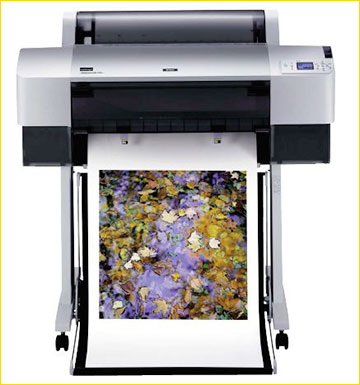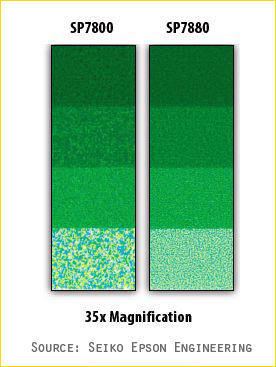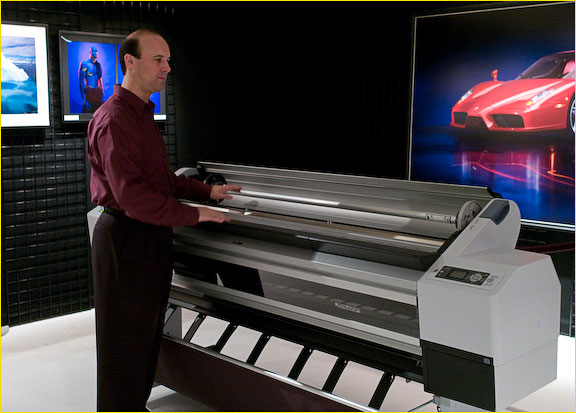Sometimes large Japanese companies act as if their national subsidiaries in various countries around the world are autonomous entities. This made a sort of sense in the days before the Internet. It would be months before any product announced in the UK, for example, received exposure in the US; usually not until air-mailed copies of UK magazines (sometimes a couple of months later) appeared on specialty news stands in a few big cities.
But,that was then and this is now(as the saying goes). Today if an Australian sub of a Japanese company announces a new product for the Tasmanian market, people everywhere in the world know about it 8 nanoseconds later, whether they live in New York or Nairobi. One only has to look at the geographic distribution of the readership of this site for this reality to become manifest.

Luminous Landscape readership distribution – July, 2007
In early July Epson USA held a media event in New York to show its new printer line, which was scheduled then for public announcement in mid-August. That sort of lead time allows journalists and retailers to prepare for new products. Non-disclosures were signed, which prohibits those attending the briefings from disclosing information prior to the announcement date.
In this instance what happened is that a week after the New York event, Epson UK announced the new line of printers. This information immediately appeared on this site’s discussion forum (as well as elsewhere on the net). Though the letter-of-the-law is that when something under NDA is publicly disclosed elsewhere one’s obligations are void, I felt unable to comment at the time, because only part of the news was released in the UK, and I was working on a report that included not just the refreshed product line but also what to my mind is the more important news, the real next-generation printers. So I remained mum online, even though others were freely discussing the4880,7880and9880printers.
Then a couple of weeks later, and still weeks ahead of the US announcement date and embargo release, Epson Australia announced the first of the true next generation printers, the64" Stylus Pro 11880.
So that’s the preamble, and why (as many people have asked) I didn’t mention the new printers for some time after they were being widely discussed online, and also why this report is somewhat briefer than I had anticipated it would be.
Thought you might like to know. Now, with that out of the way, here’s some information, and my take on the new printers. (Thanks to Epson US for many of the illustrations used).
July 27, 2007
Epson’s Printer Facelift

There are three newStylus Proprinters based on exisiting models. These are the 4880, 7880 and 9880. It can be more accurately called a facelift to the line, rather than a new series of printers.
The previous printers, the 4800 (17"), 7800 (24") and 9800 (44"), need no introduction. They are the printing workhorses of tens of thousands of photographers around the world, and arguably the line of printers which brought inkjet printing with pigment based inks to its current very high level of image excellence.
So, what does the new "80" series have to offer?
There are five headlines…
– Vivid Magenta ink
– Revised AMC Print Heads
– AccuPhoto HD Screening Technology
– Ethernet now standard, along with USB2
– 16 bit drives for Mac OS 10.5
Based on what I saw at the New York press event, discussions with Epson personnel, and sample prints which were made available, here are what each of these is about.
Vivid Magenta ink
Both the regular Magenta and the Light Magenta inks have been changed in the 80 series printers. The purpose of this update is to widen the printer’s gamut through the magenta ink revision, and provided gamut plots show that this is indeed the case. There were sample prints available that indeed showed both greater saturation in the blue / purple end of the spectrum, but also an increase in Dmax, now claimed to be 2.55.

And, to the inevitable question from current "00" series printer owners, the answer isno– the new inks will not work in the old printers. The previous design heads won’t handle them, and therefore they are keyed differently.
AMC Print Heads
The AMC moniker stands forActive Meniscus Control. If you remember your days in high school chemistry, a fluid that is shaped so that it is curved at the top is described as beingmeniscus.I assume that active meniscus control means that the ink drop shape is being carefully controlled so as to increase the accuracy and size of their placement on paper.
Be that as it may, the new heads also are said that have a new ink repelling coating technology, which I am told will help reduce ink drying on the surface and thus will reducing clogging.
AccuPhoto HD Screening Technology
One of the most critical jobs that a printer does is performed by a hidden piece of code that does the imagescreening. This is what takes the raster pattern of dots coming from the printer and translates them into the dithered ink dot patterns that produce the image on paper.
With the new 80 series printers Epson has introduced what they callAccuPhoto HDscreening, which is claimed to possess a "radical new form of math" for determining dot placement. Again, blow-ups of 35X, show a very clear enhancement over Epson’s previous generation printers. The extent to which this actually translates into enhanced image quality at normal viewing distances remains to be seen, but it certainly appears to be an improvement, as seen below.

Ethernet and Leopard
Epson has had Ethernet as an option on many printers up until now, but with the 80 series is making it standard. This is the preferred way of connecting to computers as it is more reliable over long distances than USB, and much less problematic than Firewire.
Mac OS 10.5 (Leopard) was supposed to be out by now, but has been delayed until October. When it does appear it will feature a 16 bit printing pipeline, and the new 80 series printers will have drivers that can take advantage of this feature. No special module will be used. The regular print driver, printing out of Photoshop or Lightroom, for example, will be able to send a 16 bit data stream to the printer.
Pricing and Availability
All three printers will be be available in the US and Canada in September. The 4880 will have a MSRP of US $1,995, the 7880 of $2,995, and the 9880 of $4,995. You can purchase the 4880 with the Colorburst RIP for an additional $500, and the 7880 and 9880 for an additional $1,000.
Image Quality
It should go without saying that prints which Epson had on display at their product launch in New York were outstanding. Of course the photography was superb, with images from the likes of Greg Gorman and Jeff Schewe, but the prints themselves, produced with the new printers, were more than impressive.
What to Do?
The inevitable question will be – should you buy one? My take on this is that if you already own a 4800, 7800 or 9800 the necessity of an upgrade may not be a compelling case. Yes, the new Vivid Magenta inks do increase the gamut somewhat, and do provide somewhat higher dMax. But you’ll likely only see the differences in a close side by side comparison. Less clogs from the new heads? That remains to be seen. Advantages of 16 bit printing once Leopard is released? Sure, if you’re a Mac owner, but the extent to which this advantage will translate into higher image quality also remains to be seen.
In the end, though without doubt the 4880, 7880 and 9800 are the best Epson photo-quality printers yet, and arguably as good as if not better than anything else on the market, these printers still have their Achilles heel – the need to swap black inks when changing between art / rag papers and glossy photo papers.
This has proven to be a real issue for many photographers, and has created an opening for both Canon and HP, which both companies have exploited during the past year to their benefit. Consequently, anyone considering a printer in this class who does not already own one, needs to consider the ink swapping costs and hassle (about $75 in lost ink and a half hour each way when swapping).
This ongoing issue begs the question – will Epson produce a line of large format printers at some point in the near future that doesn’t require ink swapping? The answer has to beyes, and the sign post to it is clear because of Epson’s fourth new printer just announced, the brand new Stylus Pro 11880, examined below.
Epson’s Next Generation
Epson Stylus Pro 11880

Epson US’ Professional Imaging Group Product Manager,
Mark Radogna, and the Epson Stylus Pro 11880
While the new 4880, 7880 and 9880 are what I would call face-lifts to their previous wide format printer line, the just announced 11880 is a brand new printer that points the way to Epson’s future in this arena.
Let’s get size and price out of the way first this time. This is a 64" printer (Epson’s first of this size), and it will cost $14,995 when it becomes available in October. Obviously this is not something that the typical photographer is going to purchase, though I would guess that a good many labs will see this as an exciting offering. Just as exciting for the likes of you and me though is that the 11880 is the prototype for what will undoubtedly be Epson’s true next generation of printers in more affordable and manageable sizes.
In addition to most of the new attributes of the 80 series printers detailed above, such as the Vivid Magenta inks and AccuPhoto HD screening technology, the 11880 and its inevitable siblings down the road also have the following new features and capabilities…
Simultaneous Black Inks
Yes, Virginia, salvation is at hand. Like the Epson 3800, the 11880, and presumably future printers in the Stylus Pro line have both Matte and Photo black cartridges loaded simultaneously, with the printer automatically switching inks as needed, depending on the paper being used.
Media Bar Coding
The printer has the ability to print a bar code on rolls of paper, which inform the printer of what paper is being re-loaded. This saves a lot of button pressing and on screen menu selections when putting an already used roll back in the printer. This technology has been seen previously in Canon’s iPF series printers, and is most welcome here.
MicroPiezo TFP Prints Heads
Along with simultaneous black inks the new TPF (Thin Film Piezo) head technology is the big news with the 11880. Epson’s engineering and marketing people appear very excited about these new heads. They feature nine channels rather than eight, and 360 Nozzles Per Inch (NPI – another acronym for us to learn) rather than the 180 NPI of the previous heads, including even the just introduced AMC heads in the rest of the 80 Series printers.

142,000% magnification
These new higher density heads will produce faster printer speeds (about 2X faster than the AMC heads) and also much more precise dot placement. I was shown microphotographs of ink dots that were astonishing in their uniformity and accuracy of placement. Once again though, we will have to wait to see how this actually translates into real-world image quality enhancements.

Auto Nozzle Verification and Cleaning System
Like new generation printers from its competitors, Canon and HP, the new TFP heads feature the ability for the printer to be aware of clogged nozzles as they develop. It remains to be seen how this is implemented, but presumably it will avoid the waste of time, ink and paper that happens when a head clog occurs and a large print comes out unusable as a consequence.
The Future?
Of course the question which we all want answered is, when can we expect 11880 technology in 17", 24" and 44" sizes? I have no information to share with you on this. I simply don’t know, and I imagine that few except the engineering managers at Epson do either. The reason is that the radically new TFP print heads are currently in limited production. Apparently, even though the 11880 is not going to be a huge volume seller, the new heads are so sophisticated that their manufacture is difficult, and difficult translates into expensive. Thus their appearance in a $15,000 printer, where their high initial costs can be more readily absorbed.
My surmise therefore is that in the months ahead as Epson perfects its head manufacture technology, the cost of producing TFP heads will decline, and their use in a new generation of wide-format printers other than the 64" model will become possible. Will this be next Spring, Summer, or Fall? There’s no way of knowing at the moment. In the meantime the new 4880, 7880 and 9880 offer many of the advantages of Epson’s several new technologies in a printer that you can buy today (almost), rather than 9 months to a year from now. The only major missing piece is simultanious auto-swapping blacks. The extent to which this is a deciding factor is something that each person will need to decide for themselves.
In the meantime, what will be of great interest to everyone is how the totality of Epson’s new technology performs, as shown by the first printer to use it, the Stylus Pro 11880. I have asked Epson to lend me one for installation atThe Luminous Landscape Gallery and Print Studioin Toronto so that I can test the printer and report on what is to be seen. Since I already have an Epson 7800, Epson 3800, Canon iPF 5000, and HP Z3100 at the studio, having an Epson 11880 there as well would provide for an exciting opportunity to compare technologies in real-world conditions. Epson has indicated that they will do their best to get me one from the first shipment to North America. I’ll keep you informed as to when it show up.
July, 2007
You May Also Enjoy...
Kodak DCS Pro/n
With the kind assistance of my friends atVistekin Toronto — Canada's largest professional photographic equipment dealer, I was able to briefly borrow the just-releasedKodak DCS
